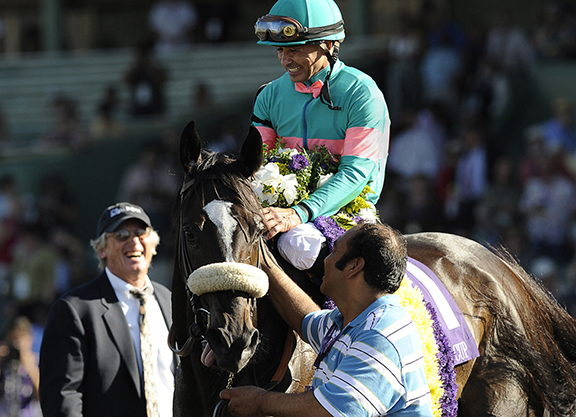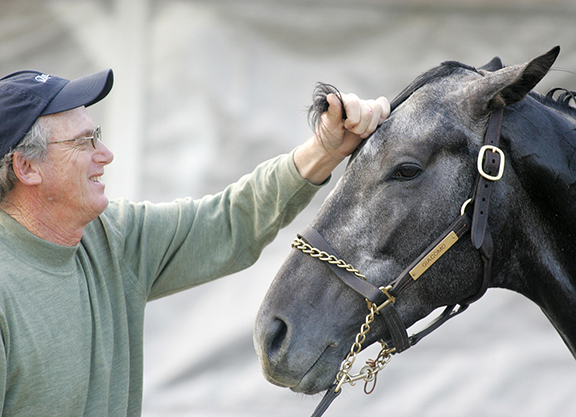Great expectations don't necessarily begin with lofty intent.
Most new licensees start out hungry for that one lionheart of any stripe to announce their arrival. Those trainers who are routinely sent the big weekend warriors learn to acquire a more refined palate, to remodulate their ambitions accordingly.
But scant few are fortunate enough to have harnessed the sort of thunderbolt that doesn't just electrify a trainer's career but leaves a patch of scorched earth for posterity. And really, how many ever expect to?
In part one, we deconstructed some of the scaffolding of the Shirreffs training philosophy-today, we take a peek beneath these outer-workings.
And where better to start than with a horse who, for three years between November of 2007 and October of 2010, danced her way to a 19-race win-streak that encompassed 14 Grade Is before signing off with a narrow defeat in the GI Breeders' Cup Classic at Churchill Downs, the collective groan to which still resonates today.
“She was difficult,” said John Shirreffs of Zenyatta (Street Cry {Ire}), as though narrating her movie trailer. “She was very difficult.”
For one, the shell was ill-designed for the engine, with back-end problems and creaky joints a source of constant headaches. “We had to be really careful with her,” Shirreffs continued. “I don't know how she did it. She overcame so much.”
Nor did it help that she was wired with an electric current, evident from the moment she pranced off the horsebox and into the Shirreffs barn at Hollywood Park that looked out onto the old training track.
“She was very highly strung and very nervous on the track. At the start, I don't know how many times I saw her drop the rider and come running back to the barn,” he said. “So yeah, she was difficult.”
By the time the 2008 GI Vanity H. at Hollywood Park rolled around, personality quirk was devolving into vice–she washed out in the preliminaries, all jittery nerves and sweat, before dispensing with her rivals in unusually grueling fashion.
“Almost cost us the race,” admitted Shirreffs, about her pre-race antics. “That's when we realized we needed to do something on the racetrack to conserve her energies.”
Shirreffs pressed reset, stood her by the quarter pole every day. Why there? “From the quarter pole, it was only an eighth of a mile walk to the gate,” he said. Stretched and supple from her parade-ring yoga, Zenyatta needed no warm-up.
“And while all the other horses were warming up, we'd stand her just to conserve her energy.”
Her next race–the GII Clement L. Hirsch H. at Del Mar–was won in customarily graceful fashion, setting a Polytrack record in the process.
“I'll have to go back to the basics.”
Superstition runs like the Nile Delta through any backstretch, with good fortune sought from many an idol, false or not-voodoo amulets nailed to the wall, lucky socks, the empty stall nearest the office reserved for the trainer's next oracle.
Shirreffs, however, appears less than dogmatic about one of the staple deities of the track-old father time, whose avatar is the trusty stopwatch. “I don't even clock my horses any more,” he said.
“What makes everybody excited? Speed. You're watching your horse work and, 'wow, we went in :23. My goodness, he's going that fast.' But the stopwatch is like a treat, right? It can give you a lot of satisfaction-but that's all it is, a treat. I think that will never change.”
Nor is he beholden to the rigid sanctity of the morning set-list. Just take Life is Sweet (Storm Cat), the 2009 GI Breeders' Cup Ladies Classic winner, a veritable sleeping beauty who Shirreffs sent out for morning exercise only when she deemed the hour ripe to rise, yawn and stretch.
And once again, patience is the key virtue when it comes to returning sheen to tarnished reputation. Or as Shirreffs puts it: “Is that not the joy of training, having fun with different personalities, doing something that'll help them bridge that gap?”
No finer example of that can be found than in Morning Line (Tiznow), a Grade I winner on the East Coast whose career had jack-knifed. Two starts after claiming pole position the GI Carter H. at Aqueduct, he brought up the rear in the GI Whitney H. at Saratoga. Jim Stark in need of a cause.
Indeed, when Morning Line arrived in California, “He would just go to the outside fence and he wouldn't move,” Shirreffs explained, about the son of Tiznow's black mood of a morning. “I didn't know what to do. So, I thought to myself, 'well, I guess I'll have to go back to the basics.'”
Back to basics isn't a euphemism for a few weeks of jogging or tack-walking around the shedrow. No, this was the equivalent of sending Einstein back to grade school.
“We would put the driving reins on him and drive him around the racetrack,” said Shirreffs, of the foundation stone of the rebel's rehabilitation.
When Morning Line became accustomed to the driving reins, then a rider was put on. When he acclimatized to both driver and rider, they increased the pace–a performance that necessitated a relay race, where the more athletic members of the Shirreffs Olympic team would be situated around the track, ready to be handed the driving reins from their rubber-legged counterparts.
“Pretty soon, it got to the point where we just started him with the driving reins, and then the rider would let go of them and carry on like usual,” said Shirreffs.
On his first start post Betty Ford, Morning Line won the GII Mervyn LeRoy H. at Hollywood Park, and two starts later, finished third in the GI Triple Bend H.
A more timely war of perseverance concerned the recently-retired Hard Not to Love (Hard Spun).
A one-eyed bag of nerves. “She obviously needed to see what was going on, so when she got nervous and upset, she just she'd have to spin around and spin around.” Shirreffs experimented with a mirror in her stall, an optical illusion for the optically challenged. “It made all the world of difference.”
Still, Hard Not to Love had a greater phobia to overcome if she were ever to make her mark. “She was terrified of the gates. Absolutely terrified,” he said.
In a nod to Hansel and Gretel, Shirreffs built a starting gate from straw. “But she'd just run through it, and then she wouldn't want to go back.” Then came an eureka moment–the same straw replica of the starting gate, but positioned around the entrance to her stall.
“So, when she went through it, tried to run, she could only go to the back wall-it made all the difference.” Indeed, the daughter of Hard Spun ended up winning the GI La Brea S. at Santa Anita, cementing herself a star of the West Coast distaff division.
“Let them drink as much as they want the first time”
Not all idiosyncrasies are created equal, however, and as anyone who sweats the details can attest, even a small realignment of the daily routine can suddenly unlock the vault. But in Express Train (Union Rags), Shirreffs is rewarded the long game.
Indeed, the improving son of Union Rags recently ran a career high when finishing second in the GI Santa Anita H., a race that once was a high-tide mark on the calendar, but in its sublimation by other dueling interests has become a barometer to the shifting fashions of the West.
It's instructive to hear Shirreffs's commentary of these changing fads, some of it dusted with nostalgia, like a hankering for the journey-man days of the old California circuit. Or a time when the backstretch community dispensed horse-sense like penny toffies.
“I was new to the track, and one day I remember Don Porter, a great trainer up North, he saw me walking into the receiving barn to give a horse a drink.
“He said, 'John, just remember the first drink a horse takes will be its biggest drink in there. So, let them drink as much as they want the first time, because otherwise they're not going to rehydrate themselves well enough.' I mean, back then people helped each other.”
Has that changed?
“I don't see a lot of that going on now,” Shirreffs replied.
Some have a historical bent, observations that betray hokey bygone truths–like the way he and others once used arsenic to stimulate the appetite and on bandages to cool the legs. “I used to use a lot of lead to help cool the legs, as well.”
Some of it reflects shifting industry winds. “I think the jockeys are fitter now than they were before. As soon as the gate opens, it's like, 'go, go, go,' right? There's more pressure on jockeys to perform all the time and in every race.”
Fitter jockey, tougher race. “Back when I started, people didn't expect the horse to win first time out-they expected the horse to have a couple of races and eventually race himself into shape. The demands on the horse are, I think, a lot higher now than they were, so we've had to adjust.”
Telling are those trainers he holds in high regard. “I think Neil Drysdale's a really good trainer,” said Shirreffs. “I think he's one of those people that understands horses and doesn't overtrain, tries to get along with them. The trouble is, he's English!
“I think Bobby Frankel was another great trainer. His approach, I thought, was always interesting. Another one who wouldn't over face them.”
Is there a connecting thread between these names? “All these trainers, I think, they just love their horses.”
If there's another, then surely it pertains to the little things. Which brings us full circle to Giacamo (Holy Bull), the horse that gave the Shirreffs name its international flavor.
The day before the 2005 GI Kentucky Derby was a lazy and warm spring Kentucky morning. Shirreffs was in the paddock schooling his great white hope, Giacomo, when the son of Holy Bull twisted off a shoe.
“We had to get him back to the barn to get re-shod, but Giacomo had very shallow feet–he really didn't have strong feet–and as you know at Churchill Downs, it's very gravely.”
Shirreffs dispatched the exercise rider to the barn, who returned with a bandage that they used to swaddle the foot, carefully led him back to the barn. The next day, Giacomo won the Derby at 50-1.
It can be all too easy to dismiss anecdotes like this as insignificant–just one of a million incidental decisions made along the winner's path. “Just doing those little things, you know, they don't seem like they're really important,” admitted Shirreffs.
But we need look no further than Sir Arthur Conan Doyle–he of Sherlock Holmes fame, with the microscope eye-for redress: It has long been an axiom of mine that the little things are infinitely the most important.
“I mean,” Shirreffs added, in explanation, “were it not for what we did, he probably wouldn't have won the Derby, right?”

The post The California Series: John Shirreffs, Part Two appeared first on TDN | Thoroughbred Daily News | Horse Racing News, Results and Video | Thoroughbred Breeding and Auctions.
Source of original post


